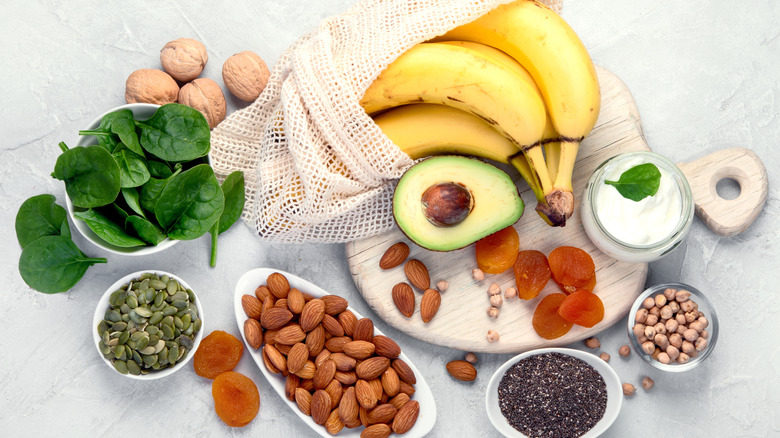The Real Differences Between Magnesium And Manganese
Maybe you've noticed that your multivitamin and mineral supplement contains both magnesium and manganese. If you find it confusing that these two essential minerals have such similar names, you're not alone. It throws many people off. However, these two nutrients are not the same thing, so it's important to keep the differences in mind. Otherwise, it could lead to some serious nutritional missteps. (You'll also want to avoid this big mistake with your multivitamin.)
One distinction to be aware of is that magnesium is a macromineral while manganese is a micromineral (also known as a trace mineral). What this means is that you need to take in much more magnesium than manganese – 420 milligrams daily for magnesium versus 2.3 milligrams for manganese. Getting the dose right is essential when taking supplements, since both minerals can be toxic if you ingest too much.
Another area where they vary is the functions they serve in your body. While you need an adequate intake of each, you can't substitute one for the other. If you take the wrong supplement, you may not reap the health benefits that you are expecting.
Let's explore what each of these minerals does in the human body and discuss some foods that are rich in each. As always, it is preferable to obtain adequate nutrition from a balanced diet rather than taking supplements to make up the difference.
Nutritional benefits of magnesium and what foods contain it
We need a large amount of magnesium because our bodies use it in so many different ways. In fact, it's a cofactor in over 300 different enzyme systems. These systems regulate protein synthesis, muscle and nerve function, blood sugar control, and blood pressure, just to name a few. Magnesium is also involved in energy production, glycolysis, and oxidative phosphorylation. It is additionally needed for the synthesis of DNA, RNA, and glutathione, and it contributes to bone development. It also aids in the transport of potassium and calcium across cell membranes so that the muscles can work and the heart can beat properly.
In general, foods that are high in fiber also contain magnesium. Some of the foods you should eat if you need more magnesium include leafy greens, legumes, nuts and seeds, and whole grains. Additionally, tap, mineral, and bottled waters can sometimes contain magnesium.
Nutritional benefits of manganese and what foods contain it
As mentioned previously, manganese is a trace mineral. While it is not utilized in the large amounts that magnesium is, it nevertheless serves some important functions. It is a cofactor for many enzymes, including manganese superoxide dismutase, arginase, and pyruvate carboxylase. Because of this, manganese plays a role in amino acid, cholesterol, carbohydrate, and glucose metabolism. It is also involved in reactive oxygen species scavenging, immunity, bone production, and reproduction. It additionally works along with vitamin K to help stop bleeding.
Similar to magnesium, manganese can be found in leafy greens, legumes, nuts, and whole grains. It can also be found in teas. However, foods high in phytic acid (beans, seeds, nuts, whole grains, and soy) as well as foods high in oxalic acid (cabbage, spinach, and sweet potatoes) may inhibit its absorption. The tannins found in tea may also somewhat reduce its absorption.


